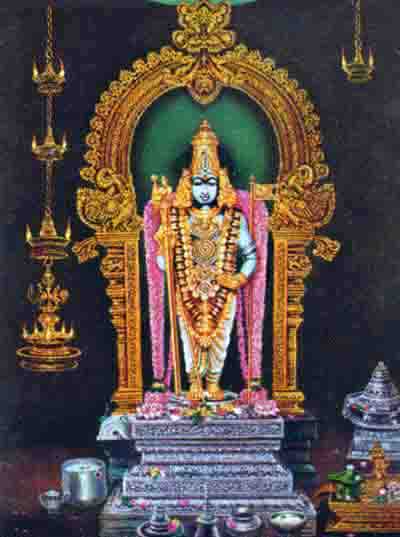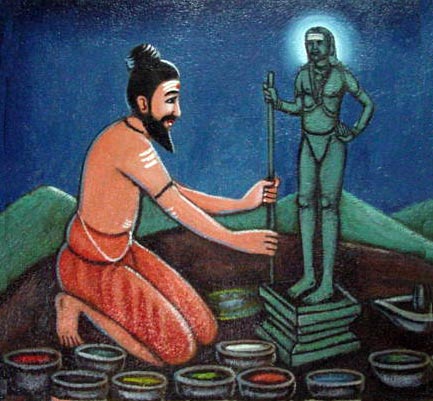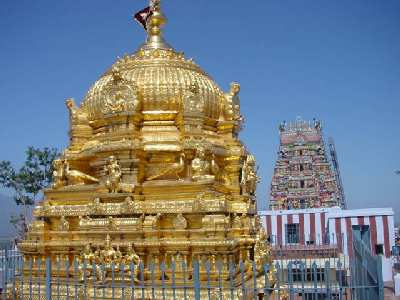
|
||||||||||||||||||||||||||||||||||||||||||||||||||||||||
|
| ||||||||||||||||||||||||||||||||||||||||||||||||||||||||
Palani Andavar icon: A scientific AnalysisM.S. SaravananPalani is the most sacred religious abode of Lord Daņdāyudhapāni. Attracting people in large numbers regardless of their religious faiths and breaking language barriers, Palani is a powerful religious healing centre. A scholar thus remarked of Palani as having "a past steeped in antiquity, legend, mythology, epic battles, stories of great sages echoing the days gone by and in time honoured literature". Put these together and you have Palani, the temple of Lord Daņdāyudhapāni on Śivagiri Hill, a part of the Eastern Ghat range of hills in Tamil Nadu, located at an elevation of about 1500 feet above seal level. From time immemorial the Palani temple has been sanctified by the penance of sages and siddhas, favoured by the patronage of kings and nobles and finally glorified by the enraptured songs in praise of Lord Daņdāyudhapāni by Tamil poets. The vibrant spiritual atmosphere combined by the traditional rituals, helps to preserve the Hindu way of life without even the slightest sign of disturbance. The hundreds of thousands of pilgrims visiting this temple bears ample testimony. Out of the six sacred bastions (Paṭai Vīṭukaḷ) of Lord Murukan, Lord Daņdāyudhapāni at Palani represents the third stage of spiritual attainment, called the manipūrakam, the other stages of spiritual progress being:
The greatness of Palani Temple can be better understood from the immortal songs of the great Saint Arunagirināthar: "My Lord, You sit on a Holy Hill which is superlative and exceeds even the spiritual glory of Kasi (Benares)." According to Saiva Siddhanta, the path to enlightenment is divided naturally into four stages of the soul's evolutionary process. Carya (virute and selfless service); kriya (worshipful sādhanās); yoga (meditation under a guru's guidance); and finally, jñāna, the wisdom state of a realized soul. For those who are striving for enlightenment, these stages may be understood as follows: carya, kriya, yoga and jñāna are the sequence of the soul's evolutionary process, much like the natural development of a butterfly from egg to larvae, from larvae to pupa, from pupa to caterpillar, and then the final metamorphosis from caterpillar to butterfly. Lord Daņdāyudhapāni at Palani represents jñāna, the final stage of the spiritual evolution of the soul. Jñāna is spiritual ecstasy, the fruit of wisdom (ñyānappaḷam). From a bud at the carya stage, through the other stages of blossom, raw fruit and then to the final stage of ripe fruit. With His majestic grace and magnetic charm, He appears in different forms to different people. For example, He appears as:
For this reason, the presiding deity at Palani attracts people from all over the world. Even the orthodox Muslims make regular visits to the Palani temple and worship the Lord. For them, the Lord is known as Palani Bādshah. Palani Āņṭavar lights the spiritual path by which the pilgrims walk through in search of their spiritual goal to attain self realisation. The temple of Lord Daņdāyudhapāni at Palani, is unique in several aspects. It also differs in many aspects from the other abodes of Lord Murukan.
The basic, and the foremost factor is the presiding deity, known as the mūlavar. It is a normal practice to sculpt the idols for all Hindu temples in granite stone. The main reason to choose granite is it's tensile strength. But other than this enormous strength, only granite stone contains all the five elements of creation, namely the panc~a bhūta-s. They are earth, water, fire, air and ether. As an exception, in Palani the idol for the mūlavar or presiding deity is believed to be made out of an amalgam known as nava pāśaņam. In Sanskrit the word nava has two meanings. Nava means both 'new' and also 'nine'. Similarly the word bhāśaņa also has two meanings. Bhāśaņa means 'poison' and may also mean 'mineral'. The observations made by the researchers who delved into the ancient literature lends support to the theory that the siddha munivar Bhogar was the one who formulated this amalgamation of nava pāśaņam. The idol for the presiding deity was sculpted out of this nava pāśaņam. It is believed that this amalgam is a clever mixture of nine poisonous metals. By this amalgamation, the poisonous nature of all these metals was harnessed, hardened like granite and converted into a beneficial amalgam with medicinal and curative values. The idol for the presiding deity was subsequently carved out of this hardened amalgam. To evolve such an unique amalgam reveals the alchemy expertise possessed by the siddha munivar Bhogar, the enormous spiritual heights achieved by him and the endless concern he had about the welfare of the followers devoted to Lord Murukan in future generations. The antecedent of this saint is seen from the very ancient literature. The bull god, Nandi Deva, is the supreme head of all siddhas. His main disciple was Tirumoolar amongst the total of seven. The seventh disciple is Kālāngi Kañjamalaiyan who in turn had five disciples. Kālāngi Kañjamalaiyan's disciple was the siddha munivar Bhoga. The genealogy is given below:
All these facts about Bhogar, the creator of the unique idol for Palani Andavar are found in the hymns of Tirumūlar called Tirumantiram. Tirumūlar is the pillar of Saiva Siddhanta who showed the right path for spiritual evolution of souls by self realisation, a process for our soul to merge with the Ultimate.
After cleverly compounding the amalgam, Bhogar chose to sculpt the figure of Lord Murukan in an unconventional style. Normally, in all the temples of Lord Murukan, the deity is sculpted with a splendour of beauty and an expression of charming adolescence. The idols always faced east. In contrast, the idol at Palani temple is quite slim with a saintly expression facing westwards with a shaven head, clad in a saffron loin cloth and holding his baton staff called the daņdāyudham. The recluse and renunciation brought out in the idol's expression, clearly flashes the message, "I am the Fruit of Wisdom". It is astonishing to note that this cleverly composed and delicately sculpted figure of the Lord has stood the effects of devotees pouring their love and devotion in the form of abhishekams. About 6-700 abhishekams are performed every month on kiruttikai days. This delicate idol has withstood all this miraculously and beyond human explanation. Nevertheless, a close examination of the idol will disturb anyone. For the region below the neck, the idol has lost its proportionate shape. The hands and feet are totally eroded by the corrosive action of the abhishekam materials. The region below the knees has become very thin and slender and now the legs look like polio affected legs, thin like two steel rods resting on a pedestal. The body region is not only eroded but appear rugged, with uneven surface and with sharp angular edges. During abhishekam, the archakas are not able to smear and rub oil on the idol, fearing possible cuts from its sharp and rugged surface. At one stage, people thought that the idol would soon buckle and fall for lack of support for the eroded legs. The devotees and the public became concerned about such a condition of the idol of the presiding deity. Several representations were sent to the Tamil Nadu State Government. Realising the seriousness of the situation, the Government took up the issue during the year 1983-84 and started considering various possibilities to ensure that the valuable idol would be preserved without any further damage at the powerful temple at Palani. The Government at one stage considered the possibility of replacing it with a new idol. At this point, the real problem cropped up. There is a code laid down by the agamas that every twelve years a temple should be renovated. On completing the renovation, a kumbabishekam (consecration) of the temple should be performed. But this has never involved the replacement of the idol. This was never done and there was no precedent. The replacement idea never occurred even in temples where the idol is sculpted out of granite. In such cases, the idol is temporarily moved to another location in the temple complex. The idol is re-installed in it's original location with new aśṭabandhanam (an adhesive material made out of herbs and made into a paste by mixing with butter). At Palani, the scenario is totally different. The strong belief is based on the tradition that the idol of the presiding deity is made out of a unique amalgam formulated by Bhogar with his divine power and futuristic thoughts reflecting his concern for future generations. The amalgam is widely believed to have medicinal qualities and curative abilities. The sandal wood paste in particular, applied on the idol and left overnight, is considered to act as a wonder drug, a panacea for many incurable and complex diseases. Every drop of water, coming out of abhishekam is consumed by the devotees with pleasure and many devotees get rid of their chronic ailments. "This curative aspect has a scientific explanation," the Devasthanam claims in one of their publications. One hypothesis says that the idol acts as a store house for millions of good bacteria and when the abhishekam materials flow over the idol the bacteria get mixed with the materials and pass on to the devotees, who get relief from their ailments. The abhishekam materials remain preserved for a considerable period of time, an example to show the curative nature of the abhishekham water. Thus it is not surprising that many siddha medical centres are based in Palani and around the Palani Hills. Since the Lord Daņdāyudhapāni at Palani is the first physician of Tamil tradition, the idea of replacing the existing idol was unacceptable. In order to ensure that the mūlavar will continue to be servicable for generations to come, the Government constituted a special committee. Justice Sadasivam, an eminent judge, a scholar of repute and a man of immense faith in religion, was appointed as the Chairman of this committee. On his assuming charge, he instituted five sub-committees to view the problem from varioius angles. The five respective sub-committees consisted of:
By virtue of my educational background, I had the great honour of being a member of the sub-committee consisting of scientists. The main objective of this committee was to find out the nature and composition of the material, out of which the idol for the presiding deity had been sculpted. As a special case, the members of this committee were permitted to enter the sanctum sanctorum along with the priests and pandarams. I considered myself very fortunate to experience this great moment, an important one, in my life. As a first step towards our investigation, we took a close look at the idol of the Lord. We were astonished when we found the face of the idol to be quite fresh with no signs of damage or deterioration. It was so clear that it looked as though the idol was recently installed. An examination of the idol under the magnifying glass, the material appeared to resemble granite or grano-dioritic material. Our happiness and surprise were only short lived, as we moved from the face to the body of the idol. It appeared in marked contrast to the condition we observed on the face of the idol. The entire body region of the idol, was full of distortions, rugged, with flaking sharp edges and the two legs were like slender sticks standing on the pedestal. With its weak support by the thinned down legs, the idol was threatening to buckle and fall down at any time. The very distinct contrast between the face and the body of the idol disproves the theory that the primary cause was the many abhishekhams. If this cause is accepted, then the question arises, "Why does the face remain fresh while the body is showing all these irregularities?" So, once in for all, this theory was rejected. The other theory, concerns the possibility of a conspiracy between the siddha doctors of Palani, the archakas and others who have access to the sanctum sanctorum. Under this scenario, the valuable material from the body region of the idol was being scrapped up by those who have access to the sanctum sanctorum, for marketing the scrappings to the siddha doctors, who in turn diluted the material and included the same in their potions for their eager patients. This, once again reflects the prolific growth of the siddha medical centres in and around Palani. Though the preliminary visual examination of the idol revealed the possibility of the material being of granitic origin. It could not be confirmed, as neither a microscopic examination nor a chemical analysis could be done in the absence of loose material from the idol being available for such detailed investigation. But we were aware that the abhishekam materials flowing over the idol could possibly absorb some of the ingredients from the idol to acquire the medicinal property, curative qualities and offer relief to many devotees from their ailments. Guided by this knowledge and taking a clue from this, we applied sandalwood paste to the idol and let it remain overnight. The next day the sandalwood paste was collected and a solution was prepared for further chemical examination, using a sophisticated instrument, the Perkin-Elmer 707 atomic absorption spectrophotometer to identify the trace elements. A standard solution required for the experiment was made to calibrate the instrument. As the next step, the sandal wood paste solution from the paste left on the idol overnight was subjected to the experiment. The instrument showed no apparent reading. The experiment was repeated several times and the instrument showed a zero absorption. When other samples were tested, the instrument showed positive results but for the sandal wood paste left overnight on the idol of the lord, the result was zero absorption. It was revealed to us as a stupendous moral - that even modern scientific analysis cannot penetrate the Divine Structure. Accordingly, a report was prepared and submitted to the Chairman of the Committee. The Chairman gathered all the reports from all the sub-committees and sent a final report to the Government with his recommendation. The committee recommended that all precautions should be taken to protect the idol by taking a major decision to restrict the number of abhishekams on the Lord. It is also widely believed that the siddha munivar Bhogar had made three identical idols and after installing the present one, the other two idols were hidden somewhere in the Eastern Ghats to be discovered at an appropriate time and by an appropriate person probably, another divine personality for replacing the present idol which had stood the test of time and started showing signs of deterioration. It is here, that one has to understand and accept human limitations. Humans can discover and harness the power of nature, but humans cannot conquer nature which is God's creation. It will be appropriate to recall the observation made by Sir Isaac Newton when praises were showered on him for his great discovery. Sir Isaac Newton modestly remarked. "All that I have done to the human community is to make a common man understand His observable laws". He added further by saying. "God created the forces of gravity. I connect this by a mathematical equation in an understandable way". The modesty displayed by the great scientist is reflected in the zero absorption shown by the instrument in our experiment on the composition of Lord Murukan's idol. It will only be appropriate to recall the verses by kavignar Kannadasan, the poet of modern times when he said, "Dwelling within the realm of Zero, ruling a Kingdom and beyond normal understanding is God. He would reveal Himself to those who understand and realise Him". Dr. Prof. M.S. Saravanan, M.Sc., Ph.D., F.M.S., F.G.S. is an an earth scientist and mineralogist and former Director of the Tamil Nadu Department of Geology & Mines and Chairman of Tarnilnadu Minerals Limited. A one-time close associate of Kripananda Variar, he was appointed Head of the Palani Andavar Idol Replacement Committee. This paper was presented at the First International Conference Seminar on Skanda-Murukan, December 1998
|


